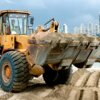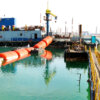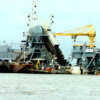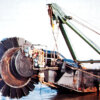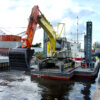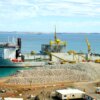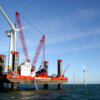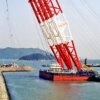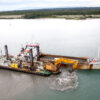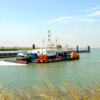The dipper dredger is a powered bucket mounted on a barge which scoops material with a forward motion like a shovel toward the dredger.
Work method
A bucket is firmly attached to the ladder structure and is forcibly thrust into the material to be removed. To increase digging power, the dredge barge is moored on powered spuds that transfer the weight of the forward section of the dredger to the bottom.
A dipper dredger plus scow barges and other equipment are transported to the work site. Some of the weight of the dredger is placed on the forward spuds to stabilise the vessels. The scow barge is moored onto the dredger with cables and winches. The dipper will scoop up the material within reach of its bucket, and the dredger will move forward by lifting the forward spuds and maneuvering with the bucket and stern spud. In this way, the dipper dredger, although not self-propelled, moves itself forward during the dredging process.
The loaded barges are towed to the disposal area and emptied by bottom dumping if an open-water disposal area is used, or they are unloaded by mechanical or hydraulic equipment if diked disposal is required.
Advantages
The dipper dredge is most effective in confined spaces such as bridges, docks, wharves, pipelines, piers, or breakwaters because it does not require much area to maneuver. The power that can be applied directly to the cutting edge of the bucket makes the dipper dredger perfect for removing hard, compacted materials, rock, or other solid materials after blasting.
Types of material
The dipper dredge is a strong piece of equipment, good for removing hard compact materials such as:
- clay,
- hard-packed sand,
- glacial till,
- stone
- blasted rock and
- old structures and obstructions.
Limitations
A dipper dredger can cause substantial sediment disturbance and resuspension when dredging fine-grained material. A significant loss of the fine-grained material will occur from the bucket during the hoisting process. They are also limited on the dredging depths that can be achieved.
Production rates
Production rates are dependent on the type of material being dredged and the size of the dipper bucket which can be quite large, the largest being about 15 cubic metres and the dredging cycles are variable but reasonable.
Project applications
The dipper dredger is most effective in tight spots, that is, near bridges, docks, wharves, pipelines, piers and breakwaters because the dredger does not require a great deal of space to manoeuvre. Since the dredging process can be very well directed and accurate, the risk of damaging structures is minimal.



